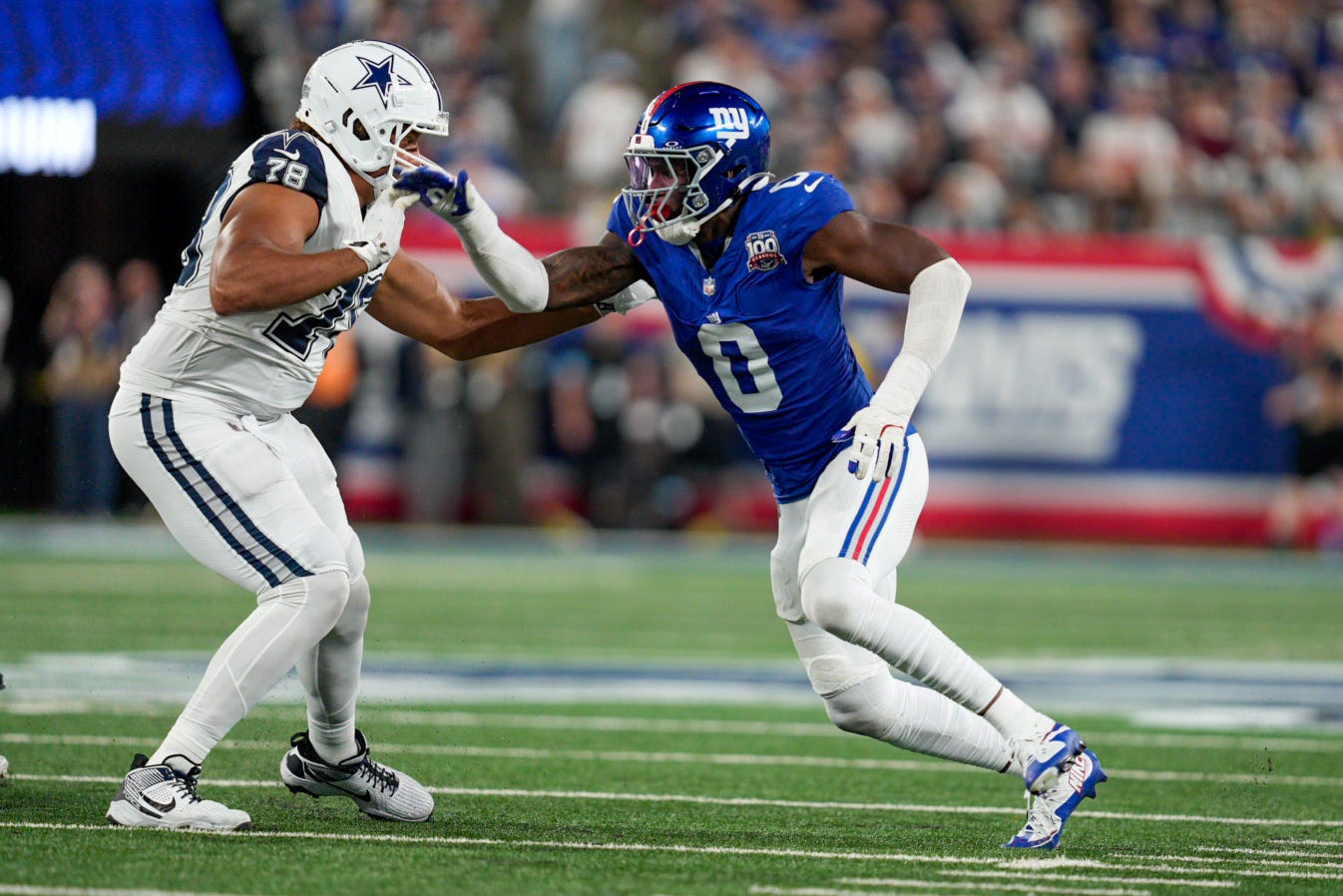New York Giants fans have been critical of their team’s defensive performances this season. In particular, star pass-rusher Brian Burns has received the brunt of the criticism this year due to his lack of box score stats through four weeks. However, a closer look at the advanced data and game film suggests Burns has been performing at a much higher level than his box score stats suggest.
Brian Burns received criticism for his Week 4 performance
This season, Burns has totaled 13 combined tackles, two tackles for loss, one sack, one forced fumble, and three pass defenses through four games. These numbers have underwhelmed Giants fans, especially after he failed to add much to his season totals in Week 4.
Burns received a lot of overblown criticism following his performance in the Giants’ Week 4 loss against the Dallas Cowboys. Next Gen Stats charted him with zero generated pressures in the contest on 25 pass rushes, sparking outrage among the team’s fans who are demanding more from their $141 million pass-rusher.
However, Pro Football Focus charted Burns with a more respectable two pressures generated on 27 pass rushes, including one hurry and one quarterback hit. He finished the game with a decent 67.2 overall PFF grade and was credited with two stops, which are defined as tackles that constitute a “failure” for the offense, indicating he was impacting the run.
Burns only had 10 rushes against “true pass sets,” however, per PFF. True pass sets are defined as a passing play that doesn’t include screens, play action, or rollout plays, eliminating all plays where the offensive linemen/pass blockers are not provided with built-in advantages, helping to determine which pass rushers are performing well on their own.
Considering he only had 10 true pass rushes, there were not many opportunities for Burns to make a pass-rushing impact in this game, due to the gameplan that the Dallas Cowboys’ offense put together. Their game plan essentially eliminated the opportunities for the Giants’ pass rush to get quick wins and pressure the quarterback.
Burns’ two pressures came on his 10 true pass sets (20% success rate), indicating that when he had a legitimate opportunity to apply pressure, he was more productive.
- Could Giants sign Kirk Cousins as bridge quarterback in 2025?
- Giants could fix their secondary with ‘top-dollar’ free-agent cornerback in 2025
- Giants could reunite with familiar face to fill key defensive weakness in free agency
Burns has quietly been one of the Giants’ best players
Burns took a slight tumble in PFF’s weekly NFL pass-rusher rankings this week following his performance against the Cowboys. However, PFF’s Ryan Smith still had some words of encouragement regarding Burns’ overall performance this season:
“Burns is tied for second on the Giants with 11 total pressures through four weeks, trailing only Dexter Lawrence,” Smith wrote. “The Giants are a top-10 team in pass-rushing grade this season, something Burns has helped fuel in his first season in New York.”
While he may have struggled in Week 4, Burns was utterly dominant in Week 3 when he faced more true pass-rushing opportunities. He totaled seven pressures in that game, including a strip-sack recovered by the Giants en route to their first win of the season. Against Cleveland, Burns faced 16 true pass set reps, and demonstrated the type of explosive difference-maker he can be when given the opportunity.
The key to creating more production for Burns will be for the Giants’ defense to force opposing teams into more true-pass sets. The way they can do this is by stopping the run, which will help eliminate the play-action passing game. If opposing teams are unable to gain yards on the ground against Big Blue, they will be forced to drop back into more true pass sets and create opportunities for Burns, Kayvon Thibodeaux, Dexter Lawrence, Azeez Ojulari, and the rest of the team’s pass rushers to get home.
So really, while Burns has room for improvement and does need to generate more pressure, the real key for the Giants’ defense to generate more pressure will be stopping the run. Currently, it is too easy for opposing teams to run the ball against the Giants, leading to a play-action passing game that minimizes opportunities for pass-rushes to get in the backfield. Football is a team game at the end of the day.
